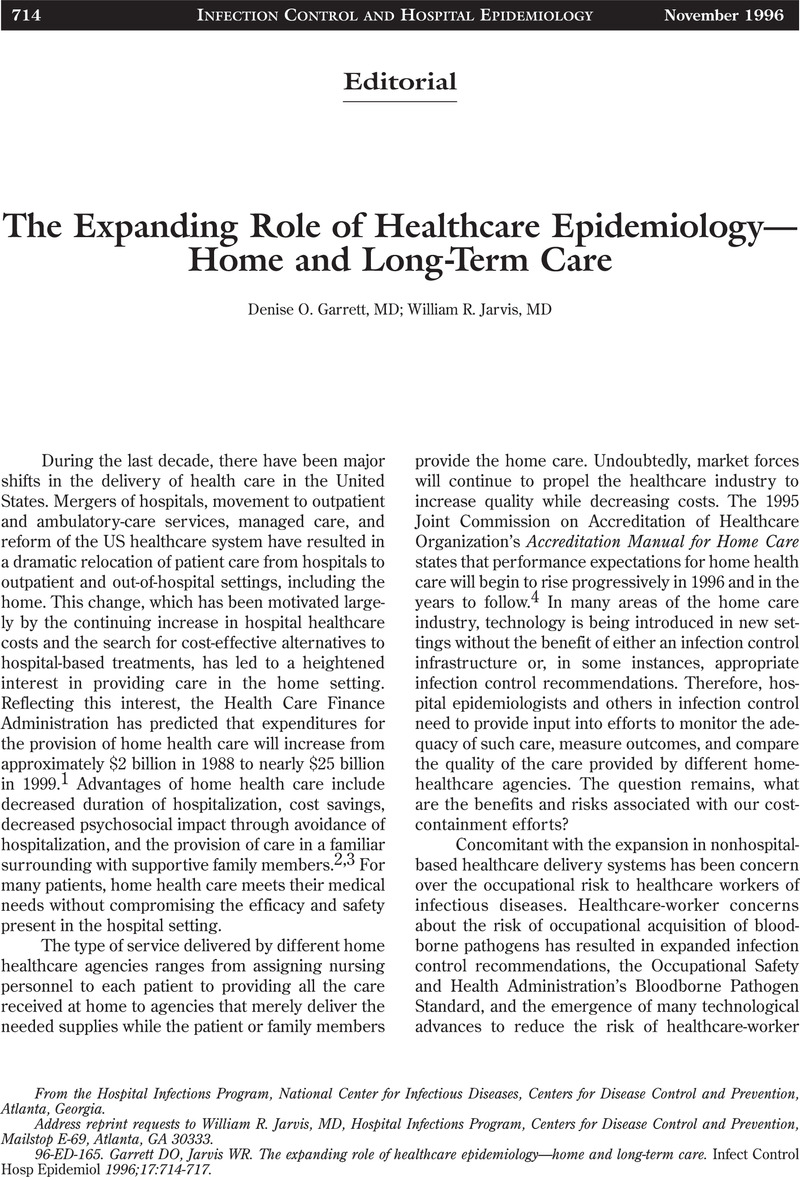No CrossRef data available.
Article contents
The Expanding Role of Healthcare Epidemiology—Home and Long-Term Care
Published online by Cambridge University Press: 02 January 2015
Abstract
An abstract is not available for this content so a preview has been provided. As you have access to this content, a full PDF is available via the ‘Save PDF’ action button.

- Type
- Editorials
- Information
- Copyright
- Copyright © The Society for Healthcare Epidemiology of America 1996
References
REFERENCES
1.
Vladeck, BC. From the Health Care Financing Administration: Medicare home health initiative. JAAMA
1994; 271:1566.CrossRefGoogle Scholar
2.
Bielory, L, Long, GC. Home health care costs: intravenous immunoglobulin home infusion therapy. Annals of Allergy, Asthma, and Immunology
1995;74:265–268.Google Scholar
3.
Grayson, ML, Silvers, J, Turnidge, J. Home intravenous antibiotic therapy. A safe and effective alternative to inpatient care. Med J Aust
1995;162:249–253.CrossRefGoogle ScholarPubMed
4.
Joint Commission on Accreditation of Healthcare Organizations. 1995 Accreditation Manual for Home Care. Oakbrook Terrace, IL: JCAHO; 1994.Google Scholar
5.
Skolnick, R, LaRocca, J, Barba, D, Paicius, L. Evaluation and implementation of needleless intravenous system: making needlesticks a needleless problem. Am J Infect Control
1993;21:39–41.Google Scholar
6.
Gartner, K. Impact of a needleless intravenous system in a university hospital. Am J Infect Control
1993;20:75–79.CrossRefGoogle Scholar
7.
Danzig, LE, Short, LJ, Collins, K, et al. Bloodstream infections associated with a needleless intravenous infusion system in patients receiving home infusion therapy. JAMA
1995;273:1862–1864.Google Scholar
8.
Kellerman, SE, Shay, DK, Howard, J, et al. Bloodstream infections in home infusion patients: the influence of race and needleless intravascular access devices. J Pediatr. In press.Google Scholar
9.
Do, A, Ray, B, Barnett, B, et al. Evaluation of the role of needle-less devices (ND) in bloodstream infections. 1996 Annual Meeting of the American Society for Microbiology, 36th Interscience Conference on Antimicrobial Agents and Chemotherapy; 09
1996; New Orleans, LA. Abstract J61.Google Scholar
10.
Pearson, ML. Guideline for the prevention of intravascular-device-related infections. Inifect Contml Hosp Epidemiol
1996;17:438–473.Google Scholar
11.
Lobato, MN, Oxtoby, MJ, Augustyniak, L, Caldwell, MB, Wiley, SD, Simonds, RJ. Infection control practices in the home: a survey of households of HIV-infected persons with hemophilia. Infect Control Hosp Epidemiol
1996;17:721–725.Google Scholar
12.
Lobato, MN, Hannan, J, Simonds, RJ, Riske, B, Evatt, BL. Attitudes, practices and infection risks of hemophilia treatment center nurses who teach infection control for the home. Infect Control Hosp Epidemiol
1996;17:726–731.Google Scholar
13.
Graham, S, Sim, G, Laughren, R, et al. Percutaneous feeding tube changes in long-term-care facility patients. Infect Control Hosp Epidemiol
1996;17:732–736.Google Scholar
14.
Poretz, D, Eron, LJ, Goldenberg, RI, et al. Intravenous antibiotic therapy in an outpatient setting. JAMA
1982;248:336–339.CrossRefGoogle Scholar
15.
Stiver, HG, Trosky, SK, Cote, DD, Oruck, JL. Self-administration of intravenous antibiotics, and efficient, cost-effective home care program. Can Med Assoc J
1982;127:207–211.Google ScholarPubMed
16.
Sarlangue, J, Maloney, S, Dixon, J, Keyserling, H, Jarvis, W. Financial impact of catheter related infections in pediatric patients receiving home infusion therapy. Third International Conference on the Prevention of Infection; 04
1994; Nice, France. Abstract CE2.Google Scholar
- 5
- Cited by


